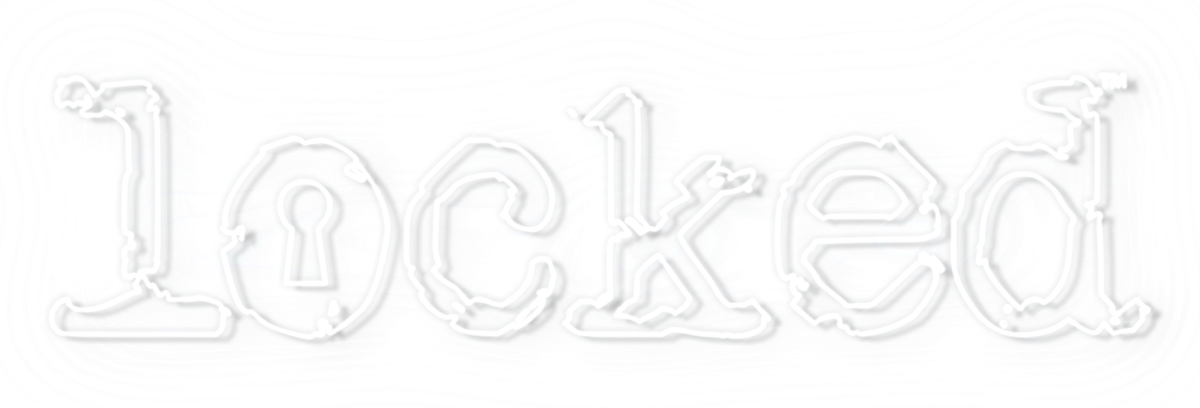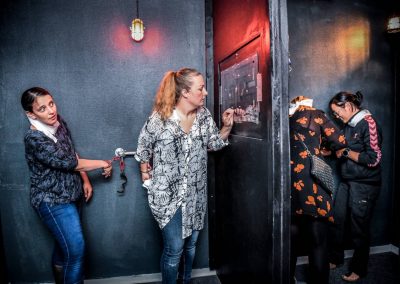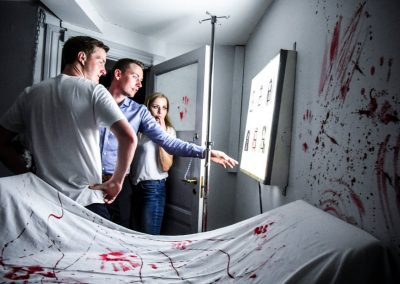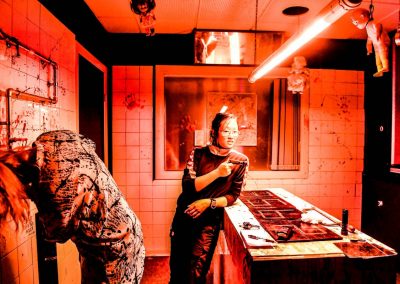What is an escape room?
- A movie where you play the lead role!

An Escape Room can be compared to a movie theater experience - but instead of sitting back in your chair, you and your team actively participate. You have to solve tasks and challenges to eventually escape the room.
Watch the video for more information:
So, what exactly is an Escape Room?
Specifically, you and your group are locked in a room! It's up to you to work together to find clues and solve puzzles to escape the room. Each puzzle you solve will allow you to open the lock to a drawer, cupboard or similar in the room, where you will find something to help you progress in the game. The experience will be full of excitement, surprises and collaboration.
Several different Escape Room themes
At Locked Escape Room, we strive to have a minimum of 3 different themes at each location - e.g. The Undead, Crime Scene and Kidnapped. This means you need to choose the Escape Room theme that you find most interesting. All themes are great, but they vary in difficulty and creepiness - you can read more about each theme under the specific section.
Are you really locked in an escape room?
No - it is always possible to leave the room in case of an emergency, as there is always an emergency exit in our Escape Room. If you and your team do not complete the room within the 60 minutes, an instructor will enter the room and go through what you need to complete the specific Escape Room. We guarantee that our Escape Rooms are fun even if you don't manage to complete the entire room.
How many people can be in an escape room?
Each Escape Room can hold a maximum of 6 people (we recommend 3-4 people for the optimal experience). If you are, for example, 8 people, you will have to split into two teams, but we always have several Escape Rooms at each location so that everyone can work at the same time.
How long does an Escape Room take?
Approximately 70-80 minutes in total. In the Escape Room itself, you have 60 minutes to complete the mission, plus a 5-10 minute introduction and conclusion.
What makes Locked the best escape room chain in Denmark?
At Locked Escape Rooms, we focus on the overall experience. Therefore, our locations are larger than our competitors' so that there is room for some large Escape Rooms, which do not just consist of one or two rooms, but always a minimum of 3 rooms. In addition, we have also made sure that all our locations have a cozy lounge, which ensures that our guests can have a good introduction and conclusion.
Each of our Escape Rooms is designed with authenticity in mind to ensure our guests can immerse themselves 100% in the scenario - no matter what theme they choose.
Overall, all our Escape Rooms are challenging, fun and safe!
Fortunately, our guests agree with the above, and this is reflected in our reviews on Facebook. Google and Tripadvisor where we have 5/5 stars everywhere. See more on Tripadvisor: HERE
Ready to book? - Select your location here: HERE
Still want to read more about Escape Rooms?
- Read more in the two boxes below:
In-depth information about Escape Rooms
What is an Escape Room?
Live Escape Rooms are a relatively new concept that originated from video games. The first Escape Room video game was released in 2004, and three years later the concept was reformed and redesigned as a live version where groups could now try out the concept in a physical room. Live Escape Rooms spread quickly in Asia and in 2011-2013 the concept spread to major cities in Europe and the US. Today, Live Escape Rooms can be found in almost every corner of the world.
Escape Rooms is a team-based game where the goal is to solve puzzles and mysteries in order to break out of the room you are trapped in.
The concept is ideal as a group activity for families and friends alike. The concept reinterprets team building and offers families or groups a whole new way to interact with each other.
Below is a brief overview of some of the elements that Escape Rooms can contain. However, please note that each Escape Room is uniquely constructed.
For example, Escape Room Herning differs from our competitors in that we have Escape Rooms that consist of several rooms - so maybe we should call it "Escape Appartment" instead.
- Team-based - Collaboration is at the heart of the whole concept. Groups typically consist of 2 to 8 people who are tasked with searching the room for clues that can help them unlock the room.
- A clear goal - Often the goal is to escape from space. However, it could also be to solve a murder mystery or something else entirely.
- A background story - Escape Rooms are based on a story such as "Escape from Prison".
- Atmosphere - Each Escape Room will be designed and decorated to match the backstory. For example, the room can be decorated like a prison cell.
- Riddles - The riddles/tasks in the room can for example involve 1) finding hidden objects around the room 2) solving math problems 3) finding hidden passwords in books. Common to these tasks is that they will be connected so that together they will provide solutions on how groups can get out of the room.
- Limited time - Typically, the group will only have 60 minutes to solve all puzzles to escape the room and complete the game.
Typical target groups:
Dr. Scott Nicholson has gathered information from Escape Rooms all over the world and based on this report, the breakdown of Escape Room players is as follows:

Dr. Scott Nicholson's report states that Escape Rooms have a broad appeal, with many different types of groups represented among visitors. Furthermore, it states that Escape Rooms appeal about equally to both men and women.
Pricing:
Escape room prices generally vary greatly depending on geographical location.
Converted to Danish kroner, Dr. Scott Nicholson has calculated the average price to be DKK 140 per person. However, prices vary widely, with escape rooms costing as little as $30 per person in Asia.
When compared to the average per capita income in the given continents, prices are more evenly distributed:
If this is applied to the Danish average income (approx. DKK 320,000) based on a price per person of 0.06% of the average income, the result is as follows: Approx. DKK 192 per person.
At Locked Escape Room, we strive to give all our guests the best possible experience. Therefore, we will evaluate each group's experience, and based on that, we will constantly try to optimize the puzzles/challenges and the layout of each room.
We look forward to bringing you an experience filled with excitement, surprises and collaboration.
How is an Escape Room built?
The process of building an escape room:
Yu-kai Chou, who has researched game development and gamification, has designed Octalysis, which is the most widely used framework in gamification. Overall, the framework consists of eight factors that ensure involvement, motivation and inspiration. These factors are important for Locked to take into account when developing Escape Rooms.
The factors are as follows:
Meaning:
The player feels chosen and can see themselves in the game through the story.
Accomplishment:
Development/progression is the motivation to stay interested.
Empowerment:
The user is involved in a creative process where they are repeatedly challenged and see the results of their process, which is important to create a balance between the game and the user. It is therefore important that things can be solved in several different ways to achieve this creativity.
Ownership:
Participants need to feel ownership of the game, which is a major motivating factor. This is seen in the form of personalization and more.
Social influence:
The social aspect of a game is crucial for the spread of a game. For example, sharing on social media, playing together as a team or creating new relationships with others through the game.
Scarcity:
This aspect is based on the fact that we as humans are motivated by things we can't have. This leads to the player maintaining an interest in gaining access to the unattainable.
Unpredictablilty:
We as humans are curious and interested in finding out what the unknown brings. Therefore, interest is kept in play when something unexpected happens. The user seeks these elements to be stimulated and surprised.
Avoidance:
This point is based on the fear of feeling left out and has become increasingly important as the individual is afraid of missing out on the experiences of other acquaintances, also known as FOMO (Fear of missing out).
Several of the above points are already used at Locked. For example, empowerment, where the user is challenged. Locked has developed several puzzles that require guests to use their creativity, intellectuality and generally think differently than usual. Unpredictability is also used as humans like to see progression and be surprised unexpectedly.
The above does not mean that it is necessary to implement all Yu-kai Chou points. Rather, it gives an overview of all the factors that can be implemented in a good game. Locked Escape Room focuses on one point in particular - the element of Accomplishment.
Inspired by the storytelling model, Locked has also built the rooms based on the desire for the rooms to evolve in order to maintain motivation and development. In the storytelling model, there is a rapid increase in tension, followed by a short drop with the opportunity for greater immersion, interrupted by a "point of no return", after which it builds up to its climax. In Locked's case, for example, all the rooms will start off "easy" and give the group a sense of success, after which the group will encounter more and more in-depth puzzles interspersed with something unexpected that surprises guests. Furthermore, the music will intensify as the game progresses and will be dominated by stressful effects such as a ticking clock in the last 10 minutes.
In addition to Accomplishment, there is also a special focus on Unpredictablilty and Scarcity. For example, guests do not know the number of locks or what is hiding behind the closed doors. In addition, Locked has deliberately placed elements visible to guests but inaccessible, for example, a key locked in a glass cabinet or by placing the keys to the handcuffs out of reach.
Ready to book?
- Select department in the menu at the top...









